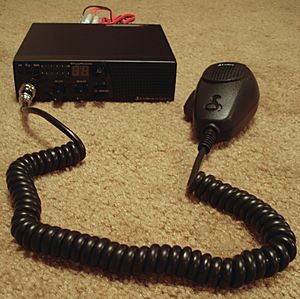Citizens band radio facts for kids

Citizens band radio, often called CB radio, is a way for people to talk to each other over short distances using radio waves. It's like a walkie-talkie system but often used in cars or homes. In many countries, you don't need a special license to use a CB radio. People use it for fun, for business, or just to chat with others nearby.
CB radios use specific channels, usually 40 of them, in a certain radio frequency range (27 MHz). Only one person can talk at a time on a channel. Everyone else has to listen and wait their turn. If you want to join a conversation, you might say "break" or "breaker" to let others know you're waiting. In the United States, channel 19 is very popular with truck drivers. Channel 9 is kept for emergencies.
Contents
How CB Radio Started
CB radio began in the United States after World War II. The government wanted to give people a way to communicate personally using radio. In 1948, the first CB radios worked on a different frequency band (460–470 MHz). There were two types: Class A and Class B. Class B radios were simpler and had a smaller frequency range.
A person named Alfred J. Gross started a company in the late 1940s to make small, handheld Class B radios. These were for everyday people to use. In the 1960s, taxi companies started using CB radios to talk to their drivers.
CB Radio Becomes Popular
In the 1970s, CB radio became very popular with truck drivers. They used it to warn each other about police speed traps or road conditions. Soon, many other drivers started using CB radios too. The special words and phrases truckers used, called "CB jargon", even showed up in movies!
Understanding 10 Codes
When CB radios first started, people used "10 codes." These were like shortcuts for longer messages. Early CB radios needed time to warm up, so these codes helped people communicate faster.
Here are some common 10 codes:
- 10-4 (ten-four): This means "message received" or "okay."
- 10-9 (ten-nine): This means "please repeat your last message."
- 10-10 (ten-ten): This means "transmission complete, standing by."
- 10-17 (ten-seventeen): This means "urgent business."
- 10-20 (ten-twenty): This means "what is your location?" People often just say, "What's your 20?"
- 10-27 (ten-twenty seven): This means "I am moving to channel ____."
- 10-200 (ten-two hundred): This means "police are needed at ____."
Who Uses CB Radio Today?
CB radio is still popular with truck drivers today. It's also used in rural areas by many different people and businesses. This is especially true where cellphone service might be weak or unreliable.
People who go off-roading in four-wheel drive vehicles also use CB radios. They talk to each other in a group to warn about tricky trail conditions, dangers, or delays. CB radio is used in many countries around the world for short-distance communication. Most of them use a similar system of 40 channels in the 27 megahertz band.
Images for kids
See also
 In Spanish: Banda ciudadana para niños
In Spanish: Banda ciudadana para niños






